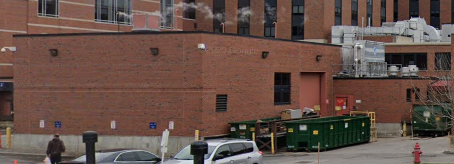
| Medical Center | Autoclave |
 |
| Autoclave Building |
The Medical Center generates a large amount of infectious medical waste that must be disposed of in accordance with relevant laws and regulations. A medical waste incinerator began operating in December 1986 in the west end of J Wing, but in 1997, the Environmental Protection Agency (EPA) released the first federal standards and guidelines regulating hospital and medical waste incinerators. The University decided in December 1977 to shut down its incinerator and to rely on a new autoclave to sterilize infectious medical waste..
A new autoclave facility was built on the north side of the Supplies and Accounts Buildings and began operation in 1998. The facility uses steam to sterilize infectious waste which is them hauled to a landfill.
The building was demolished in April 2023 to accommodate the Emergency Department Expansion and new Patient Care Tower project.
References
1998 "Study
puts area hospital on U.S. List of polluters," Democrat and
Chronicle, June 10, 1998, Page 1B. | Part
2 |
Strong expects to clean about 1.4 million pounds of waste a year by
autoclave. Since 1995, Strong has reduced by 73 percent the amount of
medical waste, said Marvin Stillman, the hospital's manager of
environmental compliance.
1998 "Hospitals
seek to be mercury-free," Democrat and Chronicle, August 5,
1998, Page 4B.
And in December, Strong closed its medical waste incinerator.
2002 "Hospitals
Recognized for Environmental Excellence," EHS Today, April
10, 2002.
University of Rochester Strong Memorial Hospital has long been a leader in
pollution prevention. It began a regulated medical waste reduction program
in 1995 that allowed it to shut down its incinerator in favor of
autoclaves. Between 1995 and 1997, the hospital reduced red bag generation
by more than 65 percent.
© 2021 Morris A. Pierce